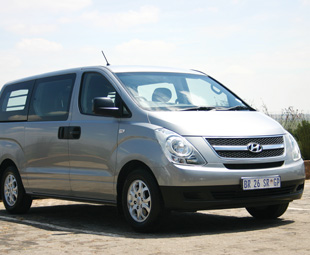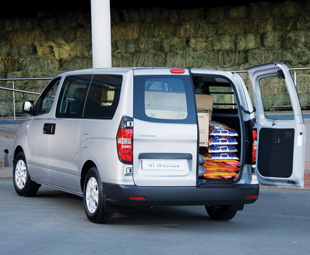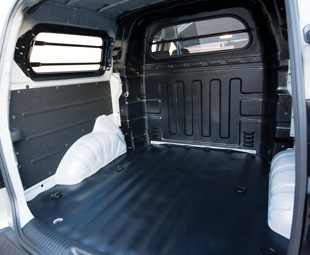The can-do Multicab!

A load-carrying van that seats up to six passengers as well? And comfortably at that. Hyundai’s fleet-flexibility solution is something the market didn’t even know it was waiting for. GAVIN MYERS discovers the wonder of its H1 Multicab.
Of late, Hyundai has been on something of a charge. From its actual products to the perception the public has of the brand, this Korean marque is barely recognisable from what we knew even a decade ago. Worldwide, it is enthusiastically expanding its portfolio with a selection of stunning and impressive vehicles, South Africa being no exception. Nor, for that matter, are other sections of the market.
In the commercial vehicle sphere, Hyundai is leading from the front with the ever-green H100 bakkie, followed by its Mighty HD65 and HD72 trucks that are swiftly proving their worth, and, most recently, the H1 range of vans and people-carriers.
We reviewed the H1 panel van last September and praised it for its powerful diesel engine, comfort, and honest approach to the application required of it. Come January 2012, and Hyundai has now given us the H1 Multicab – a vehicle that combines a sealed-off cargo area with seating for six and levels of luxury one gets in the H1 bus. At the launch of the vehicle, Hyundai Automotive South Africa marketing director Stanley Anderson jokingly referred to it as “the company’s double cab offering … with a free canopy.”
 Which is a point one has to ponder: why, when the multicab segment of the South African market accounted for all of 600 sales during 2011, does Hyundai (Korea) decide to launch this vehicle here instead of a pukka double cab? Part of the answer lies in the appeal of the H1 Multicab and the market it’s aimed at: Hyundai expects the Multicab to be a hit with corporate and fleet buyers looking for a dual-purpose vehicle designed to carry both goods and staff.
Which is a point one has to ponder: why, when the multicab segment of the South African market accounted for all of 600 sales during 2011, does Hyundai (Korea) decide to launch this vehicle here instead of a pukka double cab? Part of the answer lies in the appeal of the H1 Multicab and the market it’s aimed at: Hyundai expects the Multicab to be a hit with corporate and fleet buyers looking for a dual-purpose vehicle designed to carry both goods and staff.
Hyundai has done this by sealing off the rear compartment of the H1 bus and fitting the vertically-split rear doors of the H1 panel van. The bus’s rearmost side windows have been retained, but the side glass and window in the partition have now been secured with protection bars. The load area has a length of 1 585 mm (2 500-litre volume) and features six lashing points and an interior light above the back doors. And, with its leaf-spring rear suspension, the H1 has a payload of 1 100 kg and can tow up to 1 500 kg (braked) and 750 kg (unbraked).
Providing the motivation are the same four-cylinder 2,5-litre VGTi turbodiesel and 2,4-litre CVVT petrol engines found in the rest of the range. In the case of the Multicab, the diesel engine can only be mated with a five-speed automatic; similarly, the petrol only with a five-speed manual. Unfortunately, only the diesel versions were available for us to sample at the launch.
 This engine produces strong power and torque figures of 125 kW at 3 800 r/min and 392 Nm at 2 000 r/min (126 kW at 6 000 r/min and 227 Nm at 4 200 r/min for the 2,4 petrol) and combined with the automatic gearbox provides an easy drive. However, the autobox is slow to react to both kickdown (and driver input via the shift lever) and this can catch it out, resulting in some hunting between ratios. Regardless, though, the diesel engine pulls strongly and should have no problem when the vehicle is packed to capacity.
This engine produces strong power and torque figures of 125 kW at 3 800 r/min and 392 Nm at 2 000 r/min (126 kW at 6 000 r/min and 227 Nm at 4 200 r/min for the 2,4 petrol) and combined with the automatic gearbox provides an easy drive. However, the autobox is slow to react to both kickdown (and driver input via the shift lever) and this can catch it out, resulting in some hunting between ratios. Regardless, though, the diesel engine pulls strongly and should have no problem when the vehicle is packed to capacity.
Hyundai claims CO2 emissions of 240 g/km and combined-cycle fuel consumption of 10,2 litres/100 km for the petrol Multicab, and 257 g/km and 9,7 litres/100 km for the diesel version.
The Multicab offers its occupants a comfortable, compliant ride with lots of space front and back. The cabin really is large and airy, with ample storage spots (the same front-folding middle seatback is fitted, providing a storage tray and extra cup holders). Luxury and convenience features include manual air-conditioning; an MP3 radio with USB/Aux/iPod connectivity (including a standard iPod adapter cable); front electric windows (one touch on driver’s side) and tinted windows all-round.
On the safety side, features include driver and passenger airbags; auto-locking doors; four-channel ABS with electronic brake-force distribution (EBD) and, on the diesel-powered model, traction control.
The Multicab comes with a five-year/150 000 km manufacturer’s warranty, rust and perforation warranty, roadside assistance and five-year/90 000 km service plan, included in the price of R279 900,00 for the 2.4 CVVT and R339 900,00 for the
2.5 VGTi.
At these prices, the H1 Multicab has a lot to offer – we expect to see quite a few of them charging around.
Published by
Focus on Transport
focusmagsa



